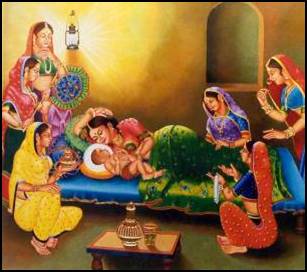|
Jai Swaminarayan
Jai Swaminarayan (also spelled Jay Swaminarayan) (Devnagari: เคเคฏ เคธเฅเคตเคฎเคฟเคจเคพเคฐเคพเคฏเคจ, Jaya Svaminฤrฤyan ; Gujarati:เชเชฏ เชธเซเชตเชพเชฎเซเชจเชพเชฐเชพเชฏเชฃ, Jaya Svฤmฤซnฤrฤyaแน) is a notable religious term used in the Swaminarayan Sampraday for both ritual and social purposes. It is used not only as a "hello" but also as a "goodbye". The idea being any thing you say or start, has to start with the God's name. People from this sect of Swaminarayan use it to start a phone conversation and end it. They use it to begin and end the congregation. People following other faiths use their own god's name for e.g. Jai Sri Krishna or Jai Ganesha. The literal meaning of the term is, "Hail Swaminarayan." Within the Swaminarayan Sampraday, the term is used as a greeting. Presently this term is used in daily puja rituals worldwide at the Swaminarayan Sampraday The Swaminarayan Sampradaya, also known as Swaminarayan Hinduism and Swaminarayan movement, is a Hindu Vai ... [...More Info...] [...Related Items...] OR: [Wikipedia] [Google] [Baidu] |
Devnagari
Devanagari ( ; , , Sanskrit pronunciation: ), also called Nagari (),Kathleen Kuiper (2010), The Culture of India, New York: The Rosen Publishing Group, , page 83 is a left-to-right abugida (a type of segmental writing system), based on the ancient ''Brฤhmฤซ'' script, used in the northern Indian subcontinent. It was developed and in regular use by the 7th century CE. The Devanagari script, composed of 47 primary characters, including 14 vowels and 33 consonants, is the fourth most widely adopted writing system in the world, being used for over 120 languages.Devanagari (Nagari) , Script Features and Description, (2013), United States The |
Swaminarayan Sampraday
The Swaminarayan Sampradaya, also known as Swaminarayan Hinduism and Swaminarayan movement, is a Hindu Vaishnava sampradaya rooted in Ramanuja's Vishishtadvaita, characterized by the worship of its charismatic founder Sahajanand Swami, better known as Swaminarayan (1781โ1830), as an avatar of Krishna or as the highest manifestation of Purushottam, the supreme God. According to the tradition's lore, both the religious group and Sahajanand Swami became known as ''Swaminarayan'' after the Swaminarayan mantra, which is a compound of two Sanskrit words, swami ("master, lord") and Narayan (supreme God, Vishnu). During his lifetime, Swaminarayan institutionalized his charisma and beliefs in various ways. He constructed six mandirs to facilitate followers' devotional worship of God, and encouraged the creation of a scriptural tradition''.'' In 1826, in a legal document titled the Lekh, Swaminarayan created two dioceses, the Laxmi Narayan Dev Gadi (Vadtal Gadi) and Nar Naraya ... [...More Info...] [...Related Items...] OR: [Wikipedia] [Google] [Baidu] |
Swaminarayan
Swaminarayan ( IAST: ', 3 April 1781 โ 1 June 1830), also known as Sahajanand Swami, was a yogi and ascetic, who is believed by followers to be a manifestation of God Krishna, or as the highest manifestation of Purushottam, and around whom the Swaminarayan Sampradaya developed. In 1800, he was initiated into the ''Uddhav'' ''sampradaya'' by his guru, Swami Ramanand, and was given the name Sahajanand Swami. Despite opposition, in 1802 Ramanand handed over the leadership of the Uddhav Sampraday to him before his death. According to the Swaminarayan-tradition, Sahajanand Swami became known as Swaminarayan, and the Uddhav Sampraday as the Swaminarayan Sampradaya, after a gathering in which he taught the Swaminarayan Mantra to his followers. He emphasized "moral, personal, and social betterment," and ''ahimsa'', and is also remembered within the sect for undertaking reforms for women and the poor, and performing non-violent yajรฑas (fire sacrifices) on a large scale. ... [...More Info...] [...Related Items...] OR: [Wikipedia] [Google] [Baidu] |
Puja (Hinduism)
''Puja'' ( sa, เคชเฅเคเคพ, pลซjฤ, translit-std=IAST) is a worship ritual performed by Hindus, Buddhists and Jains to offer devotional homage and prayer to one or more deities, to host and honor a guest, or to spiritually celebrate an event. It may honor or celebrate the presence of special guests, or their memories after they die. The word ''pลซjฤ'' is Sanskrit, and means reverence, honor, homage, adoration, and worship.เคชเฅเคเคพ ''Sanskrit Dictionary'', Germany (2009) Puja, the loving offering of light, flowers, and water or food to the divine, is the essential ritual of Hinduism. For the worshipper, the divine is visible in the image, and the divinity sees the worshipper. The interaction between human and deity, between |



